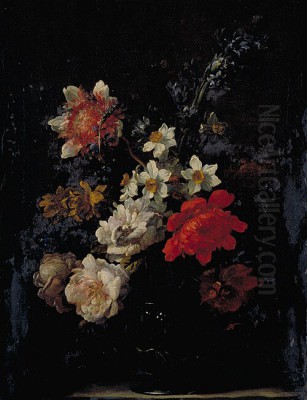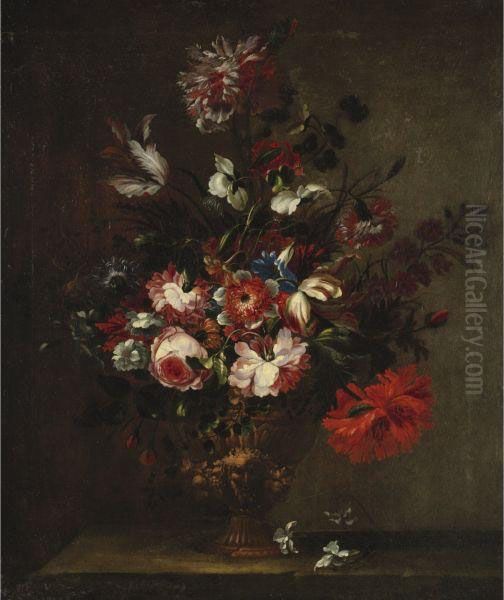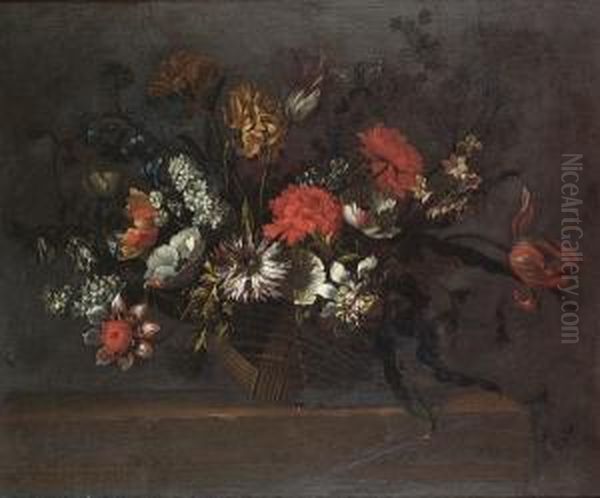
Nicolas Baudesson stands as a significant, albeit sometimes overlooked, figure in the rich tapestry of 17th-century French art. Active during a period of profound artistic development under monarchs Louis XIII and Louis XIV, Baudesson carved a niche for himself as a specialist in floral still life painting. Born in 1611 and passing away in 1680, his life spanned a crucial era that saw the consolidation of French artistic identity. While perhaps not possessing the widespread fame of some contemporaries who dominated history painting or portraiture, Baudesson's dedication to the meticulous and sensitive depiction of flowers earned him recognition in his time and ensures his relevance to art historians today. His work offers a window into the aesthetics of the French Baroque, showcasing a blend of influences and a distinctly elegant naturalism.
Early Life, Roman Sojourn, and Artistic Formation
Nicolas Baudesson was born in Troyes, a city in the Champagne region of France, in 1611. He hailed from a family with artistic inclinations, suggesting an early exposure to the world of art and craft. While details of his earliest training remain somewhat obscure, it is known that like many ambitious European artists of his time, he sought inspiration and advanced training in Italy. Rome, the undisputed center of the art world, beckoned. Baudesson spent a considerable and formative period of his career in the Eternal City, residing there from approximately 1632 until 1666.
This extended stay in Rome was pivotal for his artistic development. Crucially, he studied under the tutelage of Mario Nuzzi, who was widely known by his evocative nickname, Mario dei Fiori ('Mario of the Flowers'). Nuzzi was a leading specialist in floral painting in Rome, celebrated for his vibrant compositions and technical skill. Studying with dei Fiori undoubtedly immersed Baudesson in the techniques and aesthetics of Baroque floral still life as practiced in Italy, exposing him to arrangements characterized by dynamism, rich color, and often, dramatic lighting. This Roman influence would remain discernible in Baudesson's work even after his return to France.
Artistic Style: Naturalism, Elegance, and Influence

Nicolas Baudesson's artistic style is best characterized by its commitment to naturalism and realism, tempered with a distinct French elegance. While active during the Baroque period, known for its drama and opulence, Baudesson's works often exhibit a certain restraint and sensitivity. He focused intently on capturing the specific textures, forms, and delicate nature of individual blooms. His arrangements feel observed rather than overly contrived, showcasing a genuine appreciation for the botanical subject matter.
His time in Rome with Mario dei Fiori exposed him to the Italian Baroque's energy, but Baudesson adapted these lessons to a sensibility often associated with French art of the period. His compositions frequently display a careful sense of balance and harmony. Unlike the sometimes overflowing abundance seen in Flemish still lifes by artists like Jan Davidsz. de Heem or Frans Snyders, Baudesson's arrangements, while full, often feel more ordered and breathable. He paid close attention to the play of light on petals and leaves, using it to model form and create a sense of presence, often setting his bouquets against simple, dark backgrounds that allowed the flowers themselves to command attention.
The influence of Flemish art, which had a profound impact on still life painting across Europe, can also be detected in Baudesson's work, perhaps in the meticulous rendering of detail and texture. However, his style aligns more closely with French contemporaries who specialized in still life, such as Jacques Linard, known for his precise and somewhat austere compositions, and Louise Moillon, celebrated for her serene depictions of fruit. Baudesson's particular contribution lies in his focus on flowers, rendered with both accuracy and a graceful aesthetic that distinguishes his work within the broader Franco-Flemish tradition. His approach contrasts with the grander, more decorative floral works that would later be popularized by Jean-Baptiste Monnoyer, another key figure in French floral painting.
Representative Works and Signature Themes
Although Nicolas Baudesson was active for several decades, the number of works confidently attributed to him today is relatively modest, estimated at around fifty paintings. This scarcity perhaps contributes to his being less widely known than some contemporaries. However, the surviving works clearly demonstrate his skill and characteristic style. His primary, almost exclusive, subject matter was flowers, typically arranged in vases or baskets.

One of his most frequently cited works, often titled Flowers in a Crystal Vase or similar, and dated to around 1650, exemplifies his mature style. This painting showcases a bouquet featuring a variety of blooms – tulips, roses, carnations, and others – arranged in an elegant, transparent crystal vase. The rendering of the vase itself, capturing the reflections and refractions of light, highlights his technical prowess. The composition is balanced, the individual flowers are rendered with botanical accuracy yet arranged with an artistic sense of rhythm and flow. The elegant curves of the stems and the subtle color harmonies are characteristic, reflecting what some critics describe as a transitional style in mid-17th century French art, blending Flemish realism with French grace.
Another known work is Basket of Flowers (Corbeille de fleurs), dated 1673. As the title suggests, this composition features flowers arranged in a woven basket, a common motif in still life painting. Such works allowed artists to explore different textures – the softness of petals against the roughness of the basketry. Throughout his oeuvre, Baudesson demonstrated a consistent ability to capture the ephemeral beauty of flowers with sensitivity and precision. His works often employ a relatively focused light source, creating gentle contrasts and highlighting the delicate structures of the blossoms. The overall impression is one of quiet beauty and meticulous observation.
The Context of 17th-Century Still Life
To fully appreciate Nicolas Baudesson's contribution, it is essential to place him within the broader context of 17th-century European art, often referred to as the Golden Age of Still Life painting. This genre, which focused on depicting inanimate objects, rose to unprecedented prominence, particularly in the Netherlands and Flanders, but also significantly in France, Spain, and Italy. Artists explored various sub-genres, including floral arrangements, banquet scenes, vanitas paintings (symbolic works meditating on mortality), and depictions of scientific instruments or collectibles.
In the Dutch Republic, artists like Jan Davidsz. de Heem, Willem Kalf, Pieter Claesz, and the celebrated female painter Rachel Ruysch (though slightly later than Baudesson's main period) brought still life to extraordinary levels of realism and complexity. Their works often carried intricate symbolic meanings related to wealth, transience (vanitas), and trade. Flemish artists like Frans Snyders and Jan Fyt were renowned for their large, dynamic compositions, often featuring game and elaborate displays of food.
While French still life painting shared some characteristics with its northern neighbors, it often developed its own distinct flavor. Early pioneers like Jacques Linard and Louise Moillon favored clarity and a certain sobriety. Baudesson, emerging slightly later and benefiting from his Italian training, brought a sophisticated naturalism to the genre, focusing intensely on floral subjects. His career unfolded during the reigns of Louis XIII and Louis XIV, a period when French art was increasingly centralized and codified under the influence of the Académie Royale de Peinture et de Sculpture, founded in 1648. Although history painting, championed by figures like Charles Le Brun (the dominant artistic director under Louis XIV), was considered the highest genre, still life found significant patronage, including royal commissions.
Baudesson's Place in French Art History
Within the specific context of 17th-century French art, Nicolas Baudesson occupies a respected position as a leading specialist in floral still life. After his return from Rome around 1666, he worked primarily in Paris. His skill gained official recognition when he was received into the prestigious Académie Royale de Peinture et de Sculpture in 1670. This membership signifies his standing within the established art world of his time.
His work can be seen as bridging the gap between the earlier, sometimes starker realism of painters like Linard and the more decorative, opulent floral arrangements that would become highly fashionable later in the century, particularly through the work of Jean-Baptiste Monnoyer. Monnoyer, who worked extensively for the French crown at Versailles and other royal residences, often created larger, more elaborate compositions designed as decorative ensembles. Baudesson's paintings, while elegant, generally retain a more intimate scale and a focus on direct observation.
His contemporaries in France included artists working in various genres. While Charles Le Brun dominated the official art scene with large-scale historical and allegorical works, and portraitists like Pierre Mignard and later Hyacinthe Rigaud captured the likenesses of the aristocracy and royalty, specialists like Baudesson catered to a taste for refined depictions of the natural world. His works found their way into important collections, including those housed at the Palace of Versailles, indicating royal or high-level aristocratic patronage. He operated within an artistic ecosystem that valued different genres, even if a strict hierarchy was officially maintained by the Academy.
Later Career, Legacy, and Collections
Information about Baudesson's later career after his acceptance into the Academy in 1670 is less detailed, but he continued to paint until his death in Paris in 1680. His dedication to floral painting remained constant. While he may have had students or followers – suggested by references to the "School of Baudesson" – specific names are not well documented. His influence likely manifested more subtly, contributing to the ongoing tradition of French floral painting.
The fact that a number of his works were acquired for the royal collections at Versailles speaks volumes about his reputation during his lifetime. Today, his paintings can be found in major museums, primarily in France, such as the Louvre in Paris and various regional museums, as well as in international collections like the Haggerty Museum of Art at Marquette University, which holds a Still Life With Flowers. His work continues to be appreciated for its technical skill, delicate beauty, and its representation of a specific moment in French art history.
The relatively small number of surviving works means that each painting offers valuable insight into his methods and aesthetic. His legacy lies in his mastery of the floral still life genre, executed with a blend of Italian Baroque influence, Flemish attention to detail, and a distinctively French elegance and sensitivity. He remains a key figure for understanding the development and diversity of still life painting during the Grand Siècle. His enduring appeal is even reflected in unexpected ways, such as the use of his floral imagery in modern decorative contexts like wallpaper design, attesting to the timeless beauty of his art.
Conclusion: An Enduring Bloom
Nicolas Baudesson navigated the vibrant art world of 17th-century France and Italy, establishing himself as a preeminent painter of flowers. His extended period in Rome under Mario dei Fiori provided a crucial foundation, which he skillfully integrated with his own sensibilities and the prevailing tastes in France. His paintings are characterized by their convincing naturalism, elegant compositions, harmonious colors, and meticulous attention to detail. While perhaps overshadowed in historical narratives by painters working in the 'higher' genres of history and portraiture, Baudesson's dedication to still life resulted in works of enduring quality and charm.
He stands as a testament to the specialization that flourished during the Baroque era and contributed significantly to the rich tradition of French floral painting. His works, found today in prestigious collections like Versailles and the Louvre, continue to captivate viewers with their quiet beauty and technical mastery. Nicolas Baudesson remains an important figure for anyone studying French Baroque art, offering a refined and sensitive perspective on the timeless allure of the flower.